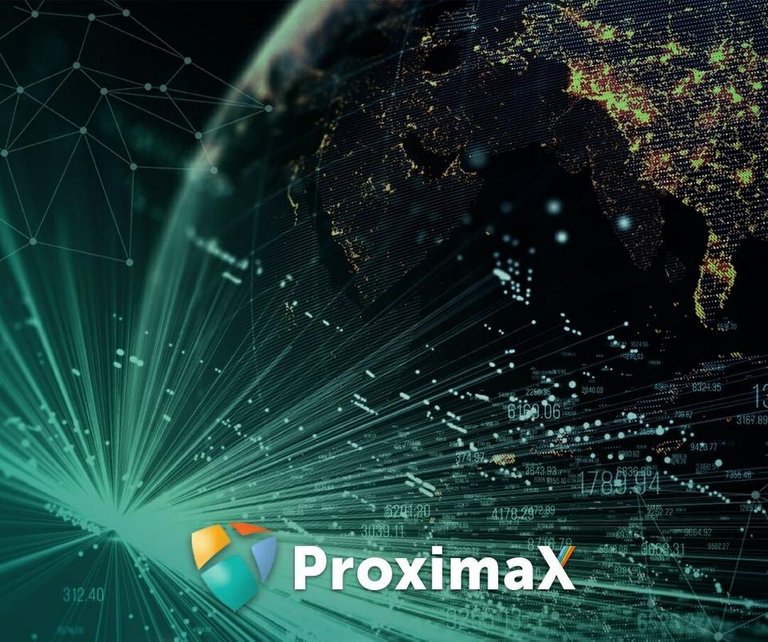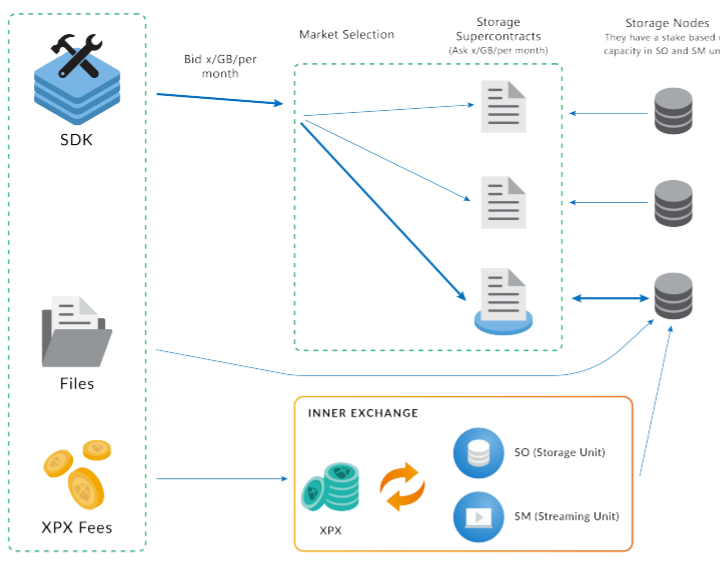
Source
Introduction
The evolution of the blockchain since its birth has been constant, and with each new project that is released, new opportunities open up, applications based on blockchain technology have grown exponentially, however, most blockchain does not provide enough tools to the new developers to facilitate the development of new apps, which contribute to the growth of blockchain technology. Now ProximaX offers unique services, specifically designed so that developers can use their services and through their convenient interface each create their own decentralized applications (Dapps).
ProximaX offers advanced services such as video transmission, identity, IoT services and Robotics among others, but to offer all these services it is necessary to know the basic aspects that ProximaX uses to make all this possible. The essential basis of ProximaX is its Blockchain called Sirius Chain that holds the entire project together.

Source
Sirius chain
It is the blockchain used by ProximaX to record all actions, transactions and events that occur in any of its basic services. Recall that the blockchain allows you to store securely formed information data that is protected with encryption technology.
Sirius Chain can be used for commercial purposes, as it has the ability to use so-called "contracts" which allows real-world assets to be represented in the form of tokens in the blockchain.
For ProximaX offering their services they decided to create token contracts that are called "Service Units" thus creating their own token economy, in order to also encourage those who facilitate and contribute to the maintenance of the blockchain network for example the nodes, thus guaranteeing the network security and quality.
Sirius Chain is a fork of the so-called "catapult" of NEM. And it was designed to offer improvements in basic services and side chains. It also incorporates improvements to the reputation system and limits the most greedy nodes through the so-called "greed test" (PoG).
Sirius storage
It is a DFMS (Distributed File Management System) system that allows binary data to be stored that are protected by several owners chosen through the consensus algorithm. Each binary data is divided into fragments and are encrypted. Each storage node is identified and encouraged by the work done.
Supercontracts
They are executable codes that are stored in Sirius Storage. And the storage of such supercontracts is rewarded to the nodes.
Sirius Streaming
It is one of the basic functions of this blockchain being possible through two methods:
1-) The data is previously recorded and stored in Sirius Storage so that it can then be transmitted to the viewers.
2-) The data is transmitted live to the viewers using nodes that replicate the data flow in real time.
Sirius Database
This is only offered as a private service, and is designed for those applications that need a database. However, it can be used simultaneously with the other public services, that is, using a hybrid configuration without affecting the quality of the services.
Sirius Content Review
It is another of the public services offered and this allows content managers to use review processes (based on consensus).
TOKENOMIIA AND TOKEN ECOSYSTEM
All decentralized public networks need to design tokens so that they are sustainable and governance is fair.
In the case of ProximaX the token ecosystem is composed of two essential parts that are divided according to their functions:
1-) Internal:
- ProximaX native token (XPX): it is used to pay for the services offered by the platform.
- Service Units: these are the units of measure for the services performed through the protocol.
-Customized Tokens: they are created by users and can be used to create their own economies within Dapp.
2-) External
- Payments made by end consumers: any payment method can be used through applications, whether tokens or fiat.

Source
NATIVE TOKEN: XPX
It is the backbone of the entire ProximaX project because in order to make use of ProximaX services users must pay with XPX
SERVICE UNITS
XPX is used to subscribe to the ProximaX Sirius public network in exchange for the so-called "service units" all this is through an automated Internal exchange. The service units can be compared with the Ethereum Gas token that is consumed by the network itself to intelligently execute contracts. In the case of ProximaX the use of the services is paid through the "gas" that is called "Service Units" on the platform.
Some uses of the service units are:
- Consumers pay for the services of the platform.
- Encourage nodes by running a service
- They represent the ability of a node to provide a service.
Types of service units:
- Storage unit (OS): this unit is used to store data. Each unit represents the ability to store the equivalent of 1 GB per month.
- Transmission unit (SM): represents the ability to move data between nodes, or nodes and consumers. Each 1 SM equals the ability to transmit 1 GB per month.
- Supercontracts Unit (SC): Represents the number of supercontracts that can be executed. Each 1 SC allows to execute 1 super contract.
- Review unit (RW): it is used for comments and content review. 1 RW equals 1 XPX of paid content.
The initial prices to be paid for the service units are reflected in USD and will be canceled with the equivalent XPX (These values are subject to change):
- 1 SO = USD 0.004
- 1 SM = USD 0.02
- 1 SC = USD 0.000005
- 1 RW = USD 0.005

Source
CUSTOM TOKEN
It allows users to create asset representations within the platform. For example they can represent a currency, a consumption or any physical asset in the real world. They can also boost the internal economy of a Dapp.
These are characterized by their names and their properties that include:
- Severability
- Duration
- Initial supply
- Mutability Supply
- Transferability.
INTERNAL AUTOMATED EXCHANGE
It is built on the Sirius chain to facilitate the exchange of the main currency of the platform (XPX) and the service units mentioned above. And it is designed so that the use of the main services of the platform are made without any inconvenience.
3-NOOD ECOSYSTEM
In decentralized networks it is necessary to know who are the actors who carry out the tasks that make it possible to offer the services. In ProximaX there are 3 types of nodes that fulfill different functions simultaneously.
- Blockchain:
It allows the validation of transactions made on the network. - Storage:
It allows the contribution of storage space in the network. The owner of said node needs to bet obtaining SO units, which represent the storage capacity of a node. - Streaming
It uses bandwidth resources to host data transmission. The owner of said node must bet obtaining SM units that represent the transmission capacity of a node.
INCORPORATION OF APPLICATIONS
Any owner of an application built on the ProximaX platform must incorporate its application. For this there are several methods and it will depend on how the application will use the platform.

Source
SIRIUS CHAIN
It is based on the latest blockchain version of NEM, which provides features applicable to commercial use cases. Making Sirius Chain attractive to build advanced services and applications.
ProximaX relies on Sirius Chain to facilitate some of the heaviest jobs, ProximaX developers improved the NEM blockchain by increasing its performance.
SIRIUS CHAIN OBJECTIVES
- Be able to process transactions quickly, safely and efficiently, at a speed of thousands per minute.
- Encourage new and existing participants to expand and secure themselves in the network.
- Scale globally using few resources.
- Be able to run on a wide variety of devices, including mobile phones and IoT.

Source
TOKENOMICS IN SIRIUS CHAIN
All blockchain-based innovations need to create a token economy.
XPX is the network's native token and will be used by all consumers who use the platform, services, and will be used to motivate node actors.
Consumers must pay XPX to use the public platform.
INCORPORATION AND DISCONNECTION OF A SIRIUS CHAIN NODE
In a decentralized blockchain network, each node goes through a process of incorporation.
For Sirius Chain, a participant must first download the node software and generate a new account or import an existing one.
The software will determine the reputation quality of the node based on history, seniority and wealth.
The software will begin the process of looking for validation work to earn a share of the rewards. The rewards earned are transferred to the node account.
To disconnect a node, the owner only has to uninstall the Validator software.
FUNCTIONS OF SIRIUS CHAIN
Sirius Chain has the following features integrated:
Account: an account is formed by a pair of keys, a public and a private one. The private key must remain as its name indicates private. Well, anyone who has the private key has full control over the account.
Namespaces: allows you to create a unique place in the chain for your business and your assets in Sirius Chain.
Mosaics: they are fixed assets in Sirius Chain that can represent a set of multiple identical activities that do not change. The mosaics can be token but they can also be reward points, stocks, bonuses and others.
Metadata: The data that is stored in Sirius Chain is immutable. However, metadata allows you to save data that is editable, updatable and can be deleted.
Multilevel of multiple signature: it is used to create multilevel agreements in Sirius Chain, this is a typical function in other blockchain but Sirius Chain has improved this function expanding its operation to create multiple levels of agreements.
Transactions between chains: it is very useful to exchange assets that are in different chains, these chains can be public or private. It is also known as atomic exchange.
Transactions added: combine several transactions in a single block, Sirius Chain does this by creating a disposable contract. When all accounts enter the aggregate transaction, all agreed transactions are executed automatically simultaneously.
SIRIUS CHAIN CONSENSUS ALGORITHM
Like most blockchain, a fair and independent ecosystem always has a consensus mechanism that determines the participants of a Sirius Chain service using PoS and PoG for this.
PoS: Sirius Chain has chosen PoS as a consensus algorithm, since it includes wealth and age as part of the system that calculates the reputation of the node, while qualifying the possibilities of a node validating transactions. It also has better performance and is more efficient than PoW which makes the network more attractive to participants.
PoG: called a greed test, it is used to ensure that a node is not overdue so there are no excessively high fees for validation. Thanks to this algorithm a scalable, equitable and equal system is guaranteed

Source
USE CASES
After seeing the essential aspects of ProximaX we can say that the amount of potential uses that the network can have is very wide, since it is expected that with the ease to create Dapps on this platform new innovative ideas will emerge.
ProximaX serves to build Dapps for payment, entertainment, storage, administration and others.
Some examples:
Games with internal economy the possibility of creating games with a blockchain-based economy is possible because with ProximaX you can create tokens without major complications and if you need storage capacity of users of said game ProximaX also provides storage services .
Cloud storage application: ProximaX provide the storage service a person could create a decentralized app in which data can be saved on the network, and these will remain secure thanks to blockchain technology.
Payment applications: with ProximaX you can represent assets either digital or physical through tokens, and with the help of supercontracts payment applications could be created with either cryptocurrencies or fiat money
Create reward tokens: If a person has a page that provides some service, they could create tokens and distribute them to their most loyal users. These tokens could be assigned a value or represent a discount to cancel the value of that service.